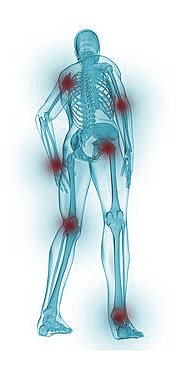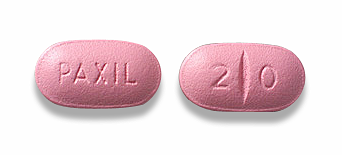Popular Articles
- Best Vitamins for Fibromyalgia Pain
- Anatrin Supplement Facts
- Herbal Treatment of Fibromyalgia
- Medications That May Interact with Anatrin
- Alternative Treatments for Fibromyalgia Pain
- Is Paleo the Best Diet for Fibromyalgia?
- 39 Signs and Symptoms of Fibromyalgia
- Omega-3 for Fibromyalgia
- 5 HTP and Fibromyalgia
- Fibromyalgia- Foods to Avoid
- More Articles ...
 Aching Joints and Muscles from Fibromyalgia?In This Article
Fibromyalgia is a complex disease with over thirty- nine symptoms. Tender points and aching joints and muscles from fibromyalgia pain is possibly the primary symptom.
Fibromyalgia pain is like no other, and those who do not have fibromyalgia have a difficult time comprehending just what fibromyalgia pain feels like. Tender points, chronic backaches, neck pain, and aching joints and muscles from fibromyalgia are a common tale among patients. Why are my muscles and joints aching?Pain is an uncomfortable signal in the body that something is wrong. It is the body’s way of alerting the brain that there is a problem that needs to be taken care of right away. After weeks and months of this alarm, the pain becomes chronic, meaning it is a part of a person’s everyday life and partially defines who the person is. Pain in the fibromyalgia patient occurs all over the body. Along with general aches and pains in the joints and muscles, there are “tender points” that are so painful that almost no medication can cut through the pain. Muscles feel like they have just finished a hard workout, and are constantly sore. They may twitch and spasm, or they will burn or feel like the person is being stabbed. Joints feel achy, as if the person has the flu or even arthritis. This joint pain may occur anywhere in the body, but especially in the shoulders, neck, back, and hips. Exercising becomes out of the question, and sleep is often impossible. How does the brain interpret pain signals in the fibromyalgia patient?Nerves in the body have nerve endings which release electrical signals. These electrical signals are like currents which move up the spinal column to the brain’s pain center. The brain interprets the kind of pain as well as the pain level. The medical journal, Psychosomatic Medicine, published a study in March 2012 which concluded that fibromyalgia patients display a massive connectivity imbalance in the brain within the pain network, even with the body at rest. Even thinking about pain causes the brain to signal perceived pain. The scientists believe that the presence of long-term chronic pain causes the brain activity to change to the point where pain is continually communicated even when no pain is present. Pain that is actually felt is communicated to the brain at a much higher level than in healthy individuals. What might be felt as a level two pain, such as a normal headache, in a healthy individual, may be felt anywhere between a level six pain to a level nine pain in someone with fibromyalgia. Level six pain in a healthy person could be considered “gripping pain,” while level nine pain might cause crying or bringing someone to their knees.
|
| Herbs for Aching Joints and Muscles |
| St. John’s Wort for depression and inflammation |
| Ginkgo Biloba for improved quality of life |
| Chlorella to reduce pain |
| Skullcap, valerian, and passionflower for insomnia |
| Green tea (Camellia Sinensis) for immune system support |
| Cat’s Claw to reduce inflammation and to boost the immune system |
| Bromelain (pineapple juice) and turmeric help reduce pain and inflammation |
| Rhodiola helps reduce stress, boosts the immune system, and is an antioxidant |
Supplements for aching joints and muscles in fibromyalgia
Several medical studies have been performed on women with fibromyalgia to show the benefits of Vitamin D for fibromyalgia pain. Recent studies have shown that most people with fibromyalgia are deficient in Vitamin D.
High dose Vitamin D therapy helped many people who suffer with fibromyalgia experience less pain and feel better in general.
The average Vitamin D level for women with fibromyalgia was 4.76 ng/mL.
Normal levels are above 50 ng/mL. Fibromyalgia patients who took Vitamin D daily and got their serum Vitamin D levels up to 50 ng.mL or higher, felt significantly better and experienced much less stress.
Web MD denotes a strong connection between Vitamin D levels and unexplained muscle and bone pain. Many people with unexplained muscle pain are now being tested for Vitamin D deficiency and are being found to have severely low levels of Vitamin D.
Taking 7000 IU Vitamin D3 daily for eight weeks significantly improved pain symptoms in patients with fibromyalgia.
Vitamin D can be obtained through sunbathing. However, few adults have the time or the occupation to allow them to spend hour after hour in the sun.
Vitamin D can also be obtained from fish liver oil. One tablespoon of cold water cod liver oil supplies 1360 IU Vitamin D, according to the Office of Dietary Supplements with the National Institutes of Health.
Fatty fish such as wild-caught salmon, supplies 500 IU Vitamin D in a three-ounce serving.
Vitamins A, C, and E can also help with achy muscles and joints in fibromyalgia. Oxidative stress contributes to the pain levels experienced in fibromyalgia. Stress reduction is more noticeable in the presence of Vitamins C and E.
 Magnesium is a critical mineral for the fibromyalgia patient. Magnesium is easily lost in the presence of chronic stress. Without magnesium, fibromyalgia patients experience muscle cramps, twitching, spasms, and aching muscles, along with many other symptoms.
Magnesium is a critical mineral for the fibromyalgia patient. Magnesium is easily lost in the presence of chronic stress. Without magnesium, fibromyalgia patients experience muscle cramps, twitching, spasms, and aching muscles, along with many other symptoms.
The Office of Dietary Supplements at the National Institutes of Health recommends a daily intake of 400mg magnesium for young men, 420mg for men over age 30, 310mg for young women, and 320mg for women over age 30.
For females with fibromyalgia, 400mg magnesium on a daily basis is a recommended starting point, adjusting either upwards or downwards according to individual results.
Up to 1000mg of magnesium may be used to help muscle and joint aches in fibromyalgia.
Another way to absorb magnesium is to take hot Epsom salt baths. The fibromyalgia patient simply soaks in a hot bathtub to which anywhere from a cup to four cups of Epson salts have been added.
Magnesium is absorbed through the skin when the pores are opened in the hot water. Soaking in the tub for at least thirty minutes every night really helps to take away stress, anxiety, tight muscles, aches, and pains in the muscles and joints.
It may take several weeks to notice real benefits, but this is simply because the body’s magnesium stores are so depleted.
Epson salt can also be stirred into a glass of pure water and drunk. Usually a pinch of Epsom salt stirred into three glasses of water throughout the day is enough. Epsom salt has a laxative effect, making it an easy way to lose weight if desired.
Taking too much Epsom salt causes diarrhea. If this happens, simply back off and use less Epsom salt. Each person’s tolerance level for Epsom salt is unique.
Calcium and magnesium work together in the body. Without enough magnesium, calcium gets deposited in joint tissues, in the kidneys as kidney stones, and in soft tissues. All of these places can cause achiness and pain.
Sodium is another mineral to consider for fibromyalgia. While many people are told to eat a low sodium diet to control blood pressure, the fibromyalgia patient may actually be low in sodium.
In 2011, researchers in the Department of Medicine at the University of Texas Health Science Center in San Antonio, Texas were able to demonstrate that sodium oxybate was able to reduce pain, sleep disturbances, and fatigue in fibromyalgia patients.
L- carnitine may also help reduce aches and pains in the joints and muscles of fibromyalgia patients, according to a clinical study performed at the University of Verona in Italy.
Melatonin has been proven to help fibromyalgia patients sleep better, which helps to reduce associated pain, according to a 2011 study published in the Journal of Pineal Research.
Yoga and strength training relieves muscle and joint aches
Yoga helps to relieve the aches and pains in the muscles and joints in fibromyalgia patients.
Its deep breathing exercises, meditation, gentle stretching, and bodyweight exercises keep the fibromyalgia patient in the present moment instead of thinking about daily stresses and pain.
Combining traditional strength training with whole-body vibration has been clinically proven to reduce pain in fibromyalgia patients better than strength training alone, according to a 2008 study published in the Journal of Alternative and Complementary Medicine.
Sources
WebMD.com, “Fibromyalgia Pain”
Pubmed. gov, Molecular Pain. 2012 Apr 26;8:32. “Patients with fibromyalgia display less functional connectivity in the brain's pain inhibitory network.” Jensen KB, Loitoile R, et al.
Pubmed.gov, Psychosomatic Medicine. 2012 Jan;74(1):55-62. "Disrupted functional connectivity of the pain network in fibromyalgia."Cifre I, Sitges C, Fraiman D, et al.





 Aching joints and aching muscles in fibromyalgia
Aching joints and aching muscles in fibromyalgia There seems to be a tolerance build-up with Cymbalta, because patients who are on Cymbalta for over six months compare similarly to patients who are on Savella (milnacipran).
There seems to be a tolerance build-up with Cymbalta, because patients who are on Cymbalta for over six months compare similarly to patients who are on Savella (milnacipran). There is little clinical support that
There is little clinical support that